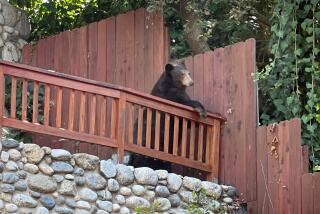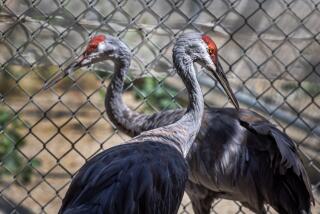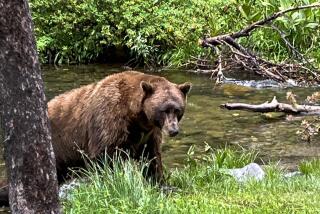Big Bear’s Burros Must Pack It In and Leave Town
- Share via
BIG BEAR CITY — Sure they’re cute, adding a quaint ambience to the rustic communities that surround this mountain lake. Maybe they’re not as sweet as a bunch of Bambies, but they’re less threatening than the local black bears.
So for a long time, everyone enjoyed the wild, free-roaming descendants of the burros left behind decades ago by gold prospectors which, over time, learned they could head into town for some easy eats.
But now, more than 100 burros are virtually domesticated, and their idea of migrating these days is to move from one yard to another--dumping trash cans, tramping gardens, gnawing on wood house trim and, in mating season, braying into the night to the consternation of many local residents.
Worse still, these furry animals are meandering out onto the local highways and being struck by vehicles or--in some cases--running into the sides of unsuspecting motorists’ cars.
Since 1989, an average of a dozen burros have been killed annually by vehicles here; last year, 22 were killed.
Finally, in a decision that is being hailed by some--and bemoaned by others--the U.S. Forest Service announced this week that it will capture the neighborhood burros and relocate them to a burro-adoption ranch at Ridgecrest, operated by the federal Bureau of Land Management.
The issue, said Forest Service wildlife biologist Robin Butler, was one of the most controversial to face authorities in recent years, pitting residents who simply adored the cute donkeys against those who feared for the animals’--and people’s--safety and saw them as nuisances who had overstayed their welcome.
“Whenever my phone rings at 2 in the morning, I figure that someone struck a burro--and I brace for the day that someone will be killed” in such an accident, Butler said.
Even benign neighborhood grazing through trash cans can become deadly. “One burro ate a plastic bag out of a garbage can, suffocated and keeled right over on a woman’s front porch,” Butler said. Others harm themselves by digesting toxic garbage or cutting themselves on tin cans and glass. And local ranchers contend that the burros pass viruses on to livestock.
The Forest Service tried to relocate the troublesome burros 10 miles out of town, in a territory where they are protected by the federal Wild Horses and Burros Protection Act of 1971.
But the burros were lousy at reading maps and savvy at sampling the suburban smorgasbord, and within 24 hours they were back, said Mitch Iverson, a federal range management specialist. “I watched one head in a full trot back into town,” he said.
Little wonder that these burros have learned how to work their charm on local residents. On Tuesday, Mae Peairs peered out of her living room window and saw five burros--including a 3-day-old foal--grazing in her yard, beneath the towering junipers and alongside a swing set. In a housecoat and fuzzy slippers, she walked outdoors into the patchy snow and tossed them carrots that she buys in bulk just for such an occasion.
“Oh yeah, I like them! They knock over my garbage, but they’re hungry,” she said sympathetically.
Others take a stubborn, more mule-like approach to the burros, and apparently for good reason.
Last year, Sotera Willis was driving through the middle of town--her 9-month-old son, Jordon, secure in his car seat--when a burro ran onto the highway from a side street.
The animal slammed into the front right fender of her Isuzu Trooper and was flipped into the back door--missing Jordon’s passenger door but causing $5,000 damage to the car. The injured animal had to be destroyed by authorities.
“Yeah, they’re adorable--but I hate to see them dying,” Willis said. “They could live just as happily somewhere else, where they won’t be hurt. Burros don’t belong on the highway.”
California Highway Patrol Sgt. Doug Rich recalls the day he was rushing to a traffic accident and three burros jumped onto the highway from a high embankment. He swerved and missed two of them, but struck the third one, which was pregnant with a full-term foal. Both animals died, and Rich’s Ram Charger squad car was totaled.
“And the very next night, a burro ran out in front of a gentleman in a Pontiac and the animal came through his windshield,” Rich said.
“These animals are more dangerous than deer or bears because they’re heavier--the size of a horse. . . . They can be spooked by something--maybe someone throwing rocks at them--and run right out into the highway. And during mating season, they’re plain-old crazy.”
Rich lives in Big Bear “and I have them in my own yard. I accept that as a fact of life, but the driving is the dangerous part.”
Among the burros’ fans are Janet Stevens-Moore, a local real estate broker who said a compromise should have been forged--by allowing the burros to stay, but admonishing residents to not feed them and to better store their garbage.
“They’re an integral part of the history of our valley,” she said, and the residential neighborhoods have now “become a natural habitat for them.”
“They have a right to be here as free-roaming and wild. Man cannot bend nature to meet his needs. Man should be the one who bends.”
The reason vehicles and burros collide, she said, is that people simply drive too fast.
The Forest Service’s decision to remove the burros will not be enacted until summer--giving people time to appeal the decision, Butler said. Once the process begins, it should take about two weeks to rid the town of burros, she said.
More to Read
Sign up for Essential California
The most important California stories and recommendations in your inbox every morning.
You may occasionally receive promotional content from the Los Angeles Times.










